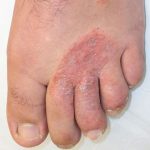 A contagious skin disease caused by parasitic fungi affecting the foot, hands, causing itching, blisters and cracking. Also called dermatophytosis.
A contagious skin disease caused by parasitic fungi affecting the foot, hands, causing itching, blisters and cracking. Also called dermatophytosis.
Fungal infections on the feet, often smelly.
A skin disease that can spread from the feet to other parts of the body and is caused by fungus. Signs are dry, scaly skin; itching; inflammation; and blisters.
A fungal infection of the foot, causing itching, blisters, and cracking of the skin.
A fungal infection of the feet characterized by itching, peeling of the skin, esp. between the toes, cracking, bleeding, and oozing of lymph.
An infectious skin disorder between the toes, caused by a fungus.
Fungal infection (ringworm) of the foot, generally starting between the toes, causing itching. Later, a bacterium may replace the fungus and cause the skin between the toes to turn white, crack, and peel off. Treatment is by antifungal preparations.
A common infection of the skin between the toes, which leads to itching and soreness; also known as tinea pedis. Athlete’s foot is a form of tinea (a group of related skin infections caused by different species of fungi). Fungi thrive in moist, warm areas. Athlete’s foot seldom affects children younger than age 12.
A fungus infection of the skin between the toes: a type of ringworm.
A loose term applied to a skin eruption on the foot, usually between the toes. It is commonly due to ringworm, but may be due to other infections or merely excessive sweating of the feet. It usually responds to careful foot hygiene and the use of antifungal powder.
A scaling, cracked, or macerated rash, typically found between the toes and usually caused by a fungal skin infection (e.g., tinea), although bacteria may also be involved. The rash is usually mildly itchy.
An inflammatory reaction set up in the skin of the toes, which, having become spongy by perspiration, lose their resistance, and become contaminated with a fungus, Tinea pedis. It is probably true that the fungus does not attack normal skin but only that of very sweaty feet. Foot baths of potassium permanganate will effect a cure. These baths are prepared by adding to a basin of lukewarm water just enough crystals of potassium permanganate to color the water a rich red. The feet are placed in this for ten minutes night and morning for seven to ten days, after which the fungus is usually destroyed. The next stage in treatment consists of restoring the spongy skin to normal by exposing the feet to the air whenever possible. One method of doing this is to make up the bottom of the bed with the sheets folded in a similar way to the top of the bed, so that the feet are exposed to the fresh air all night. This may not be very comfortable but it is effective in allowing the sweat to evaporate and so preventing the skin from becoming spongy again. Also, people who suffer with sweaty feet should, when possible, wear shoes rather like open Indian sandals, which allow the perspiration to evaporate during the day, instead of being encased in the shoe and sock, thus creating a wet atmosphere for the toes. The skin can then be hardened by bathing the feet in a strong brine solution, or in alum foot baths made up by dissolving one teaspoonful of powdered alum to each pint of water. These foot baths should be taken night and morning. After bathing, the skin should be dried carefully. Surgical spirit should be applied liberally to all crevices in and around the toes, and the foot should then be freely dusted with a dusting powder. Clean socks should be worn daily. Also called ringworm of the foot.
